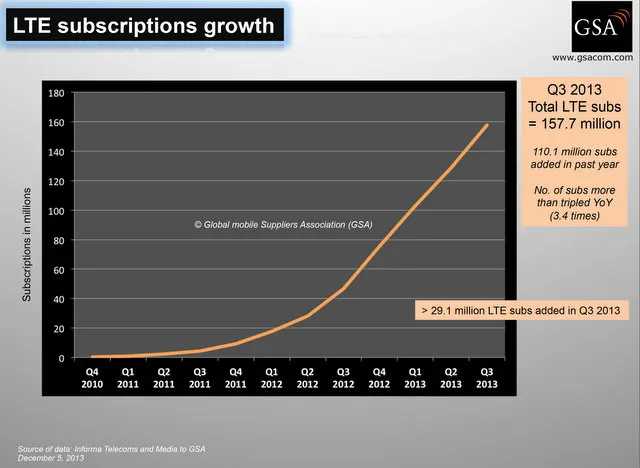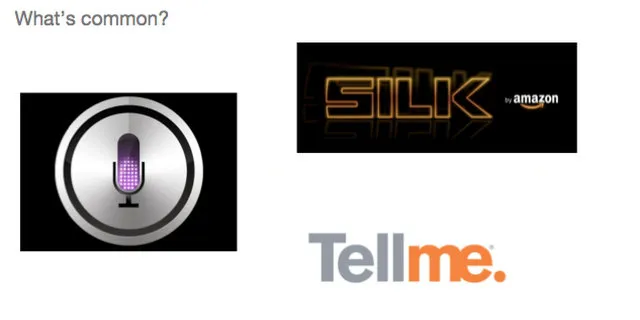Top 5 Mobile and Wireless Technology Predictions for 2014
1. Ubiquitous mobile broadband, and faster!
You expected that, didn’t you? Just that you might not have guessed how fast this adoption is going to be! More and more operators are jumping into the LTE/LTE-Advanced bandwagon. This means that every mobile user is going to have a much fatter and faster pipe than ever before. Sure, we predicted this to happen in 2012, but in wireless, after the 3G fallout, things have slowed down a bit. But now, given the data of the existing subscriptions, I wouldn’t expect the curve to flatline now. Also, given that the newer technologies are more efficient in using the bandwidth, cost per bit is significantly lower (about 10X!) than older technologies. So, slightly higher CAPEX is offset by higher margins and better user experience.
What does it mean to you, as a startup? Assume faster connections between the mobile device and as mentioned in “As a founder, be your startup’s toughest critic!”, re-evaluate all your assumptions periodically. If you had left out network related features assuming that they would be ‘too slow’ on a mobile, time to re-evaluated them!

2. Network is the computer
This is the direct side-effect of prediction #1 – Mobile is becoming incredibly fast! We now have a ‘Desktop Class’ 64-bit processor (as claimed by Apple) in a phone and we now have some devices powered by quad-cores and octa-cores! (Who saw them coming couple of years ago?) Still there are benefits of using the cloud backend as a super computer for some seriously challenging problems for various reasons (having a common algorithm across devices, network data aggregation, and obviously, having unlimited computing power). This will help in big problems like voice recognition, image processing and some performance improvements across devices.

You can see that some features like Siri, Amazon Silk and Microsoft Tellme use this kind of architecture to power their implementation. There will be more adoption of this architecture by more and more apps.
Startup Impact: Use it or make it! Have a cool idea on how to solve this problem in a beautiful way? Go ahead and make it, and don’t forget to write a check to me if you make your millions! (Check out the uber cool Amazon Silk intro video)
3. Hyper customized content
All your fears will come true. Just joking – not really! Content service providers will be able to model your behavior more and more accurately. You might say this has been happening since the days of Pandora. However, with new technologies the content will be customized based on the user, day/time, temporal trends, device (phone / tablet / TV), connectivity (WiFi, Fiber or LTE/3G etc) etc. Now, you can enjoy content on your device without having to turn the knobs.
As content also goes to cloud (iTunes Match) and streaming becomes more popular than buying (Pandora, Rdio, Spotify) companies will be able to model the user more and more accurately.
4. Identifying tech and the battle of NFC vsiBeacon
Every connected device has an IP address, and every person with some cash to spend has a smartphone. (Don’t smite me for this statement!)
There have been very good attempts in locating a user inside premises of shops, theaters, malls etc. They have not been very successful, at least so far. Apple also acquired a company that works on indoor maps (WiFi Slam).
With iBeacon slowly being launched (almost with very little noise), we will soon have ways to identify users within a shop, returning users and offer customized discounts on what they want with reasonable model of the user. This can be as good as re-targeting, but with user coming to a shop instead of visiting webpages!
With iBeacon, even payments should be made easier. So, I predict an Apple vs Google showdown in iBeacon (based on Bluetooth LE) vs NFC. (Now I can understand why I Apple didn’t add NFC to its iPhone 5S)
There are some advantages to Bluetooth LE compared to NFC especially with a larger range, but we’ll have to wait and watch. (I am betting on the former!)
5. Larger pockets in shirts, jeans/pants
This is not tech, but with phone sizes increasing, I surely see a market in increased shirts with larger pocket size. I recently checked out a Lumia 1520 in a mall in Bangalore. I just found it impossible to keep it in my pocket! I was so worried it would fall off. And that time I truly wished there were shirts with larger pockets when I can carry phones like Lumia 1520, Galaxy Note 3 and HTC One Max. While you are working on that, can I also keep an iPad Mini?

I remember Steve Job’s keynote on iPad Nano (Watch the first 2 mins), where he pulled it out from his jean’s coin pocket. I wonder what he would dot if he had to pullout a device of this form factor.
The picture from versus.com shows the relative sizes. But, you really have to see these devices in person to feel the impact.
As startups, if you are focusing on people with these devices, you also have a fantastic display, full HD capabilities, mind numbing computational power and super fast internet. So, think of something, but you can never sell one to me (I hope I don’t have to eat my words!)
Have an awesome 2014!







